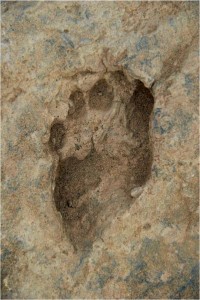1.5 million years old early human Footprints uncovered in Kenya
 Footprints uncovered in Kenya show that as early as 1.5 million years ago an ancestral species, almost certainly Homo erectus, had already evolved the feet and walking gait of modern humans.
Footprints uncovered in Kenya show that as early as 1.5 million years ago an ancestral species, almost certainly Homo erectus, had already evolved the feet and walking gait of modern humans.
Such foot prints are also found in Pakistan at many places but have been related to religion one way or the other. One such foot print is at Bolan Pass near much and it is regarded as foot print of Hazrat Ali. However the stones near Rohri Sukkur are evident that homo sapians lived in the Indus valley about 2 million years ago.
An international team of scientists, in a report Friday in the journal Science, said the well-defined prints in an eroding bluff east of Lake Turkana “provided the oldest evidence of an essentially modern humanlike foot anatomy” and added to the picture of Homo erectus as the prehumans who took long evolutionary strides — figuratively and, now it seems, also literally.
Where the individuals who made the tracks were going, or why, is beyond knowing by the cleverest scientist. The variability of the separation between some steps, researchers said, suggests that they were picking their way over an uneven surface, muddy enough to leave a mark as an unintended message from an extinct species for the contemplation of its descendants.
Until now, no footprint trails had ever been associated with early members of our long-legged genus Homo. Preserved ancient footprints of any kind, sometimes called “fossilized behavior,” are rare indeed.
The only earlier prints of a protohuman species were found in 1978 at Laetoli, in Tanzania. Dated at 3.7 million years, they were made by Australopithecus afarensis, the diminutive species to which the famous Lucy skeleton belonged. The prints showed that the species already walked upright, but its short legs and long arms and its feet were in many ways apelike.
Studying the more than a dozen erectus prints, scientists
determined that the individuals had heels, insteps and toes almost identical to those in humans, and they walked with a long stride similar to human locomotion.
The researchers who made the discovery, as well as independent specialists in human origins, said the prints helped explain fossil and archaeological evidence that erectus had adapted the ability for long-distance walking and running. Erectus skeletons from East Asia revealed that the species, or a branch of it, had migrated out of Africa as early as 1.8 million years ago.
The lead author of the journal report is Matthew R. Bennett, a dean at Bournemouth University in England, who analyzed the prints with a new laser technology for digitizing their precise depths and contours. The tracks were excavated over the last three years by paleontologists and students directed by John W. K. Harris of Rutgers University in collaboration with the National Museums of Kenya

0 comments:
Post a Comment